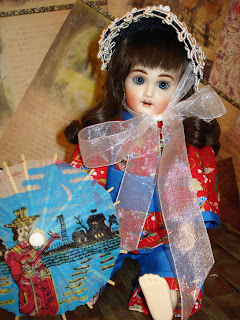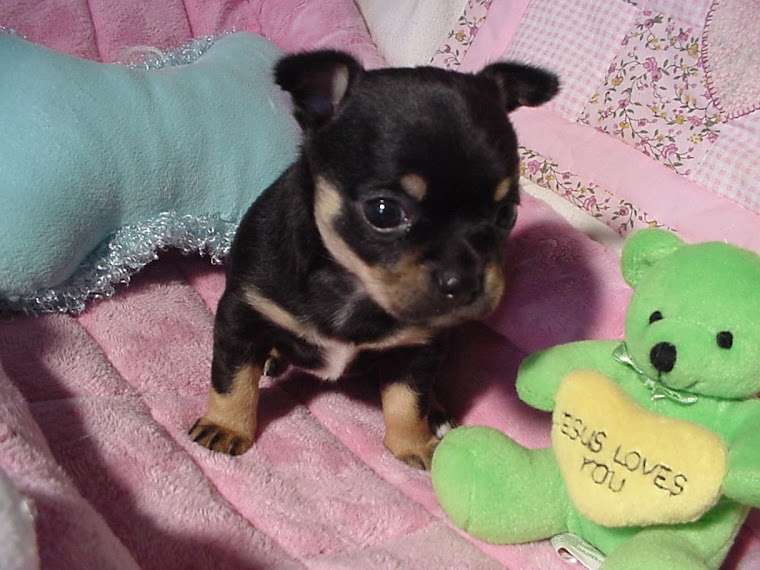
Saturday, October 31, 2009
Tuesday, October 27, 2009
Beautiful Dolls Posted on my Ebay.

Posted on my Ebay a great selection of gorgeous Dolls, Thank you for your time.
http://cgi.ebay.com/ws/eBayISAPI.dll?ViewItem&item=270476164334&ssPageName=STRK:MESELX:IT
Thursday, October 22, 2009
Chatty Cathy Dolls (one of my many favorites)

Mattel was well-known for their talking toys and doll in the 1960s, and Chatty Cathy was the doll that started it all for them. Although there had been attempts at "talking" dolls for 60 years (since the time of Jumeau's Bebe Phongraphe) Chatty Cathy was the first sure-fired talking doll hit. With her pull string talking mechanism and phrases such as "Please brush my hair," she captured the hearts of an entire generation of little girls.
Mattel also re-issued Chatty Cathy dolls twice, in 1969 (with the voice of Maureen McCormick from the Brady Bunch) and again in 1998 and 1999 for collectors.
Mattel, best known for the Barbie doll, produced Chatty Cathy Dolls. All Chatty Cathy dolls are made of vinyl. The dolls have a soft vinyl face, except for the later dolls made in 1964 which have a hard plastic face. Collectors generally prefer the soft vinyl face. All Chatty Cathy dolls are 20 inches tall.
You can find lovely Chatty Cathy dolls in excellent condition (but generally mute) for $300 to $400. Dolls with flaws sell for much less. Rarer Chatty Cathys, including truly mint dolls, black dolls, Canadian dolls and #1 Chattys (which have no marks) can sell for considerably more, with mint Black Chatty Cathys often selling for over $1,000 and mint in box Chatty Cathys often selling between $600 and $900. Pigtail hairstyles are also desirable.
Mattel based all of their talking dolls in the 1960s on a pull-string mechanism. Chatty Cathy's mechanism was truly innovative--it allowed the doll to say a phrase completely at random when the string was pulled. The internal system consisted of a needle, small turntable, and record. Over time, the governor belt (a glorified rubber band) in most of these dolls has snapped, rendering the phonograph system inoperable and the doll mute.
If one talking doll is a hit, then a family of talking dolls is better! Or, so Mattel thought. After hitting a home-run with Chatty Cathy, Singin' Chatty, Charmin' Chatty, Tiny Chatty Baby, and Tiny Chatty Brother were also produced. None were as popular with children in the 1960s or with collectors today as the original Chatty Cathy.
All Chatty Cathy dolls are marked on their backs. Marks include the copyright date and generally the doll's name (Chatty Cathy, Chatty Baby, Tiny Chatty Brother, etc.) Only the #1 Chatty Cathy has no body marks.
Thank you very much for taking the time to read my Blog, I hope everyone enjoys this week selection, Please check my Blog often I post a diferent doll on a weekly basis, Thank you again for being part of my Blog & My Life.
Monday, October 19, 2009
Friday, October 16, 2009
The Beautiful Wood Dolls

Wood is one of the earliest known materials used to make dolls. However, very few dolls are made of wood today--wood is not a preferred material for children's dolls (and wasn't in the 20th century) because wood is hard and unyielding. Also, most wood dolls must be hand carved since wood does not lend itself to easily molding as does vinyl, bisque materials.
Wood was one of the earliest materials that dollmakers looked to, since wood was easily carved to resemble human form, and it was sturdy and unbreakable. However, most wood dollmaking was done by artists or by cottage industries. Today, most wood dolls are made by doll artists (such as Jean Lotz and her Hitty dolls) or in special limited editions for collectors (Madame Alexander). Wendy Lawton makes highly poseable wood bodies for her porcelain-head dolls.
What Types Of Dolls Have Been Made Out Of Wood?: The earliest dolls made out of wood were not playthings--they were symbolic and ceremonial figures, often of a religious nature. Italian creche figures made for hundreds of years are an example of this. Some of the earliest known examples of wood dolls made for play are from England, and later Germany as well. Today, most wood dolls made are created for collectors. They have a particularly folk-art feel to them, and are prized because they are handcrafted.
As mentioned, wood dolls are known from ancient times. Italian creche figure examples are known as early as the 1500s (very rare) and English wood dolls from the late 1600s and early 1700s are quite rare. English wood dolls are more plentiful from the late 1700s and early 1800s, and German Grodner Tal and Peg Wood dolls are from the 1800s. A cottage industry created peg woodens well into the 20th century, and there are artists today still making wood dolls.
Sizes and Characteristics of Wood Dolls: i have a Grodner Tal peg wooden from the mid-1800s in my collection that is 2" tall. Grodner Tal and Tuck Comb dolls in the 3" to 5" range are often found. Most wood dolls tend to be in the 10" to 18" range with a few larger--much larger than 24" and anything made of solid wood is quite heavy and unwieldy.
The names of most early companies that produced wood dolls in Europe have been lost to time. Most wood dolls have been hand-carved by artists or artisans, or are from small cottage industries. In the United States, companies (artists) that produced wood dolls in the late 1800s include Joel Ellis and Mason, Taylor. Today, as mentioned, several artists make Hitty (a popular storybook character) including Jean Lotz. Madame Alexander makes Wendy Woodkin wood dolls hand-carved in China today.
The very earliest wood dolls, when found in excellent or better condition, generally sell for many thousands of dollars at auction. French Court dolls and very early English dolls from the late 1600s and early 1700s are dolls that are in this category and which can sell from $5,000 to $50,000 or more. An early Italian creche figure sold at auction at Theriault's last year for $21,000.
Later Queen Anne dolls (which are not actually from the Queen Anne period) from the late 1700s to early 1800s can be found for much lower prices, especially when worn.
American wood dolls such as Joel Ellis and Mason, Taylor dolls are generally found quite worn today, with prices from $500 to $1,000. German Grodner Tal and Tuck Comb dolls vary, from a few hundred dollars to a few thousand for very early or large examples, and those with unusual hairstyles and other features.
Modern wood dolls, such as the Wendy Woodkin series from Madame Alexander, generally sell between $150 to $300. Hitty doll reproductions vary widely in prices.
Hope you enjoy this weeks history of the Wood Doll, Thank you for being part of my Blog.
Wednesday, October 7, 2009
Monday, October 5, 2009
Googly's Doll History

Googly dolls are dolls with large, oversized, side-glancing eyes. Googly dolls also often have a small watermelon-shaped smile. The dolls have an impish look and appeal. The very first Googly dolls (also referred to as Googlies) were produced from about 1912 onward, and were mostly made by German doll companies.
Most bisque antique Googly dolls were made from 1915 through 1925. However, even today, dolls with oversized, side-glancing eyes can be referred to as Googlies.
Sizes of Googly Dolls: The vast majority of bisque antique Googly dolls are small--under 12 inches tall. There are some larger, rare antique googlies. Later Googly-type dolls, such as composition Campbell Kids, can be larger. Googlies tend to be painfully cute, and their small stature is part of the cute persona.
The first antique Googly dolls were mostly made of bisque. Later, Googly dolls have been made in nearly all common dollmaking materials, including composition and vinyl (Campbell Kids), and celluloid.
The classic German antique Googly dolls were produced by companies including Armand Marseille, Kammer and Reinhardt, Heubach, Kestner and others. American Character, Horsman and others have produced the Campbell Kids.
Some Famous Googly Dolls: Some famous dolls are also Googly dolls. Kewpies, which may have overall inspired Googly dolls, are also a type of Googly doll. The Campbell Kids are a great example of a later Googly doll. Today, even some anime-inspired dolls, with their big heads and oversized-eyes can even be classified as Googlies.
For the past few years, the prices of choice antique Googly dolls have stabilized after skyrocketing in the late 1990s and early 2000s. More common antique Googly dolls, like the Armand Marseille 823, can be purchased for hundreds of dollars, while some of the very rare Hertel & Schwab and Kammer & Rhinehart Googlies can cost many thousands of dollars. Later Googlies, such as the vinyl Campbell Kids, can easily be found in mint condition for well under $100.
Hope everyone enjoy's this week History of the beloved Googly Doll, Thank you for being part of my Blog, enjoy your evening.
Ana
Just listed 3 beautiful dolls on my Ebay
Subscribe to:
Comments (Atom)








